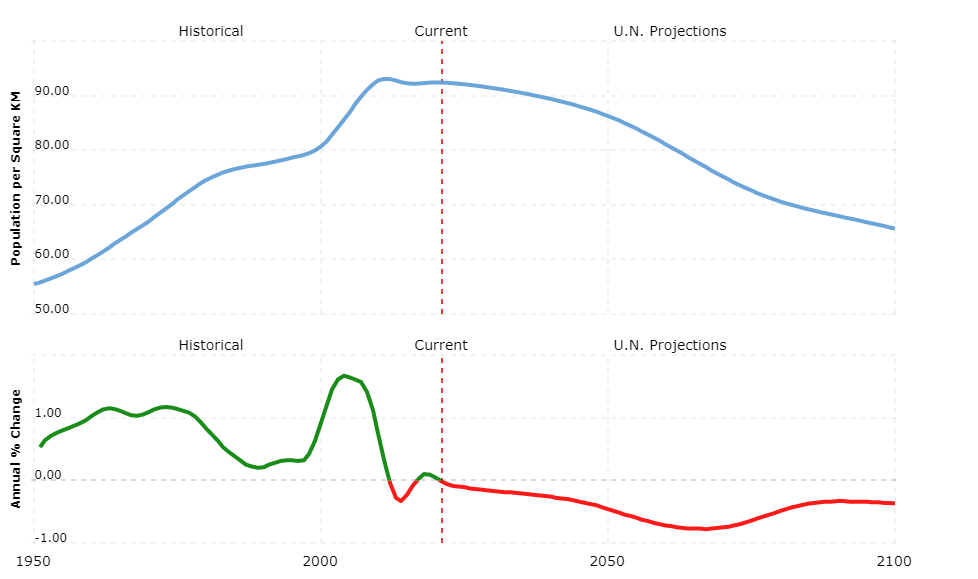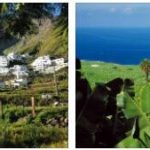| Reino de España | |
| Official language | Spanish, Catalan, Basque, Galician |
| Capital | Madrid |
| Form of government | Parliamentary monarchy |
| Area | 504.645 km² |
| Residents | 46,235,000 |
| Currency | Euro |
| Time zone | UTC + 1 CET, March to October: UTC + 2 CEST |
| License plate | E |
| Internet TLD | .it |
| Telephone area code | 0034 (Source: ALLCITYCODES) |
Geography
The Kingdom of Spain (Spanish España, officially Reino de España) is located in southwestern Europe. It shares the Iberian Peninsula with Portugal, which is located in the west of the country. Other neighbors are in the north-east of Andorra and France, in the south of Gibraltar, which belongs to Great Britain. In the east and southeast, the country is surrounded by the Mediterranean Sea, in the southwest and northwest by the Atlantic. Spain also includes the Balearic Islands, a mountainous archipelago in the western Mediterranean, the Canary Islands, which lie off the north-west coast of Africa in the Atlantic, and the North African possessions Ceuta on the northwest tip of Morocco and Melilla, an enclave on the Moroccan Mediterranean coast. See Spain country abbreviation.
The total area of the country is 504,645 km². The country is therefore somewhat smaller than France and about five times larger than Portugal.
The Iberian Peninsula is bordered in the north by the Pyrenees, a fold mountain range that stretches 435 km from the Mediterranean to the Atlantic.
Most of Spain occupy plains. The Meseta plateau forms the center of the country. It is divided by the Castilian Scheidegebirge into a southern part, about 650 m high, and a northern part, about 800 m high. Outlying areas are located around these plateaus: the Cantabrian Mountains in the north, the Iberian Outlying Mountains in the east and the Sierra Morena and the Betische Cordillere in the south. The 3,482 m high Mullhac¨¦n in the Sierra Nevada is the highest mountain on the mainland. Between the southern mountains is the Guadalquivir basin, which stretches towards the Atlantic, between the Iberian outcrops and the Pyrenees lies the fertile Ebro basin, which is separated from the Mediterranean by the Catalonian highlands.
At 910 km, the Ebro is the longest river in Spain. It rises in the Cantabrian Mountains and cuts through the Catalonian highlands. It flows into a swampy delta about 100 km south of Barcelona in the Mediterranean. Other important rivers in the country are the Tagus and Duero as well as the Guadiana and the Guadalquivir. The Tagus is the longest river in the Iberian Peninsula and the second longest in Spain. It has a length of 1 007 km, originates in the center of Spain and flows into the Atlantic below Lisbon. The Duero is 895 km long, originates in the Iberian outcrops and flows into the Atlantic in Porto, Portugal. The Spanish-Portuguese border is 122 km long.The Guadiana also originates in Spain and flows after 778 km as a border river between Portugal and Spain in the Gulf of Cadiz. This is where the Guadalquivir flows, which flows over a distance of 657 km from the Andalucian mountains to the Gulf of Cadiz. The Atlantic coast of northern Spain forms numerous bays, on parts of the Mediterranean coast there are so-called Albuferas (Arabic for coastal lakes).
Mallorca, Menorca, Cabrera, Ibiza and Formentera as well as some smaller rocky islands form the Balearic Islands. The mountainous archipelago in the western Mediterranean is up to 1 445 m high, 5 014 km² and autonomous region of Spain.
The Canaries consist of the islands of La Palma, Tenerife, Gran Canaria, Fuerteventura, Lanzarote, Gomera and Hierro as well as other smaller islands. The archipelago is of volcanic origin and lies in the Atlantic. Like the Balearic Islands, the Canary Islands are an autonomous Spanish region. They have a total size of 7 273 km², the highest mountain with 3 716 m is the Pico de Teide, which is located on Tenerife.
Climate
The Spanish mainland has a highland climate with cold winters and hot summers. The average temperatures in the capital, Madrid, in the center of the country average 6 °C in January and 24 °C in July. In Barcelona, which is more northern but on the Mediterranean Sea, the temperature is 6 °C in January and 25 °C in July. These values are only higher in Seville in southern Spain (January 10.5 °C, July 28 °C). La Coruna in northwestern Spain, on the other hand, has similarly warm January temperatures (10 °C), but summers are much cooler with an average of 19 °C.
The amount of precipitation in the country is different. While the northern Atlantic coast in particular is influenced by year-round west winds, which are accompanied by precipitation of up to 3,000 mm per year, the rest of Spain is dry, particularly in summer and winter. During this time, high-pressure locations prevent rain clouds from entering the interior, so that the main precipitation is recorded in spring and autumn. The annual rainfall in Madrid is 445 mm, in Barcelona and Seville on the Mediterranean at 585 mm and 565 mm and increase in La Coruna up to 935 mm.
The climate in the Canary Islands is subtropical and characterized by a dry northeast trade wind. The climate in the Balearic Islands shows small temperature contrasts, in January the minimum temperature is 9 °C, in August the maximum is 26 °C. This corresponds approximately to the temperatures in Barcelona. The annual rainfall, however, is lower than in the Mediterranean city, averaging 450 mm.
Flora and fauna
The vegetation of Spain is shaped according to the different amounts of precipitation and temperatures. Deciduous forests stand on the rainy Atlantic coast. Once almost completely covered by forests, heath areas with gorse and heather are growing in the cleared areas that were left to their own devices. In the mountainous regions of the northern Meseta and the Iberian and Betic Cordilleras facing the rainy west winds, deciduous oaks and beeches as well as sub-Mediterranean trees such as sweet chestnut occur. The few airy forests in the summer-dry zones are often formed from holm oaks, areas with a little more rain are covered with cork oaks.At greater heights, the oak forests merge into beech and pine forests, for example in the Pyrenees and the mountain ranges in the center of the country. The rest of the country, about 50%, is occupied by Mediterranean vegetation. The Ebro Basin with its grass steppes, but also in the dry south-east of the country, shows the first parallels to the wide steppe areas of North Africa. Kerme oaks and lavender are common plants in this area. The Mediterranean vegetation in Spain has two forms, both of which are the result of centuries of human influence. Macchie is the name of the vegetation that has taken the place of cleared evergreen forests, typical plants are the myrtle, laurel and strawberry tree.Garigue vegetation arises on even drier soils, which has even lighter vegetation than the Macchia and from knee to man-high shrubbery with rock roses,
The volcanic soils of the Canary Islands allow a wide range of plants to thrive, especially those in the lowlands that are used to hot and dry climates. A Mediterranean-looking flora flourishes at a height of more than 400 m and holly, laurel, myrtle and other trees can be found at higher altitudes at lower temperatures. The Balearic Islands have a typical Mediterranean vegetation.
Not only culturally, Spain has been particularly influenced by Africa in its fauna. In addition, the Pyrenees were an effective barrier to the rest of Europe. As a result, there are still European wolves and brown bears in Spain in the natural zones of the north (such as in the Pyrenees), animals that have since been exterminated in other Western European countries. In contrast, the gorse cat with its dark-spotted fur is a predator that migrated from Africa early on.
In addition to these extraordinary animals, wild boar, ibex and wild goats as well as red deer are found in the country. Spain is also an important migration and nesting area for numerous bird species. In the Guadalquivir region in particular, but also throughout Spain, eagles, owls, buzzards and pheasants can be found. Another special feature are the swarms of locusts that fly in from time to time and are carried from North Africa across the Mediterranean to southern Spain.
Population
According to COUNTRYAAH, 46.24 million people live in Spain. The largest city in the country is the capital Madrid (3.27 million residents). It lies in the center and is the political, cultural and economic center of Spain. Another city of millions is Barcelona (1.62 million residents). It is an important port city on the Mediterranean coast surrounded by mountains. Valencia in the coastal cordillera has around 798,000 residents. The most important city in the Balearic Islands is Palma de Mallorca with around 405,000 residents. The capital Las Palmas de Gran Canaria has 383,000 residents in the Canary Islands.
The Iberian Peninsula was populated by both North African and European peoples, so that the ethnic origin of the people is diverse. Today the following sub-groups can be distinguished: Around three quarters belong to the Castilian-speaking population. These include Castilian, Asturian, Aragonian and Andalusian. Catalans who speak their own language make up almost a fifth of the population. The Galician ethnic group (7%) is close to the Portuguese and has developed its own folk culture and language. The Basques, a small minority, also have their own pre-Indo-European language.
The official language is Spanish, which is based on the Castilian dialect. Recognized regional languages are Catalan, Basque and Galician. 95% of the population belong to the Roman Catholic Church, which was the state church until the democratic revolution.
The residents of the Balearic Islands speak a Catalan dialect. The Guanches, the indigenous people of the Canary Islands, became part of the Spanish settlers after the Spanish conquest in the 15th century.
The Spanish population grows by around 0.1% each year and has an average life expectancy of 80 years. The literacy rate is 98%.

Political system
According to the 1978 constitution, Spain is a parliamentary monarchy. The parliamentary representation consists of two chambers: the Chamber of Deputies (Congreso de los Diputados), whose 350 delegates are elected for four years, and the Senate (Senado). It consists of 264 members, of whom 208 are elected for four years in the provinces and autonomous communities of the country, and 56 are appointed. The head of state is the king (Juan Carlos I since 1975), who cannot be held politically responsible and is the commander-in-chief of the armed forces. It can schedule elections and convene and dissolve parliament. He also proposes the candidate for prime ministerial office (since December 2011, Mariano Rajoy Brey) and appoints the cabinet members at his suggestion.
The country’s most important parties are the Socialist Workers’ Party (PSOE), the People’s Party (PP), the Catalan Convergence and Union (CiU) and the United Left (IU).
According to the constitution, the formation of autonomous communities with internal self-government is permitted. The country consists of 17 autonomous regions (Comunidades autonomas), 50 provinces and two autonomous cities (Ceuta and Melilla on the African continent).
Economy
Spain’s economy is the twelfth largest economy in the world. Structural change has transformed the former agricultural country into a modern, competitive industrial country. In recent years, growth has declined significantly (2012: -1.4%), among other things as a result of the growth cycle peak being exceeded and the US real estate crisis and the slump in housing construction also resulting from the real estate crisis. This had a significant impact on the employment situation: the unemployment rate, which fell to 8.2% in 2007 (compared to 24.2% in 1994), was 26% at the end of 2012. The government responded with numerous cuts and savings.
The division of the Spanish economy corresponds to European standards. 71% of gross domestic product (GDP) is generated in the area of services. The share of agriculture is declining and is currently just under 3%. A significant part of the agricultural land today is unused. Grain and viticulture is mainly carried out on the plateaus, in the south is the center of the olive crops, which make Spain the global market leader in olive oil production. Maize and potatoes are grown in the northwest, fruit, vegetables, cotton, tobacco, lemons, nuts and almonds in the east and southeast. Sheep breeding is mainly found on the plateaus. Fishing still plays an important role, especially tuna and sardines.The main fishing ports are in Galicia,
Mining focuses on the production of mercury, lead, copper, hard and brown coal, iron ore and sulfur gravel. Spain is one of the world’s largest car manufacturers. Other industrial core areas are shipbuilding, mechanical engineering as well as communication and IT.
Tourism is one of the most important sources of income for the Spanish economy. Although this has declined slightly in recent years, Spain was still the fourth most popular travel destination in the world in 2011 with 53 million tourists. In terms of numbers, visitors to Spain prefer to travel to Catalonia, the Balearic Islands, Andalusia or Valencia.
The most important trading partners are the EU member countries, especially France and Germany. The most important export items are automobiles, agricultural products (especially fruit, vegetables, olive oil and wheat), chemical products and equipment. In particular, energy sources, automobiles, electronics, machines and chemical products are imported.
Spain’s main ports are Barcelona, Bilbao, Valencia, Gij¨®n, Seville, Avil¨¦s and Las Palmas. The most important international airports can be found near Madrid, in Barcelona and (due to tourism) in Palma de Mallorca.
The currency is the euro.







